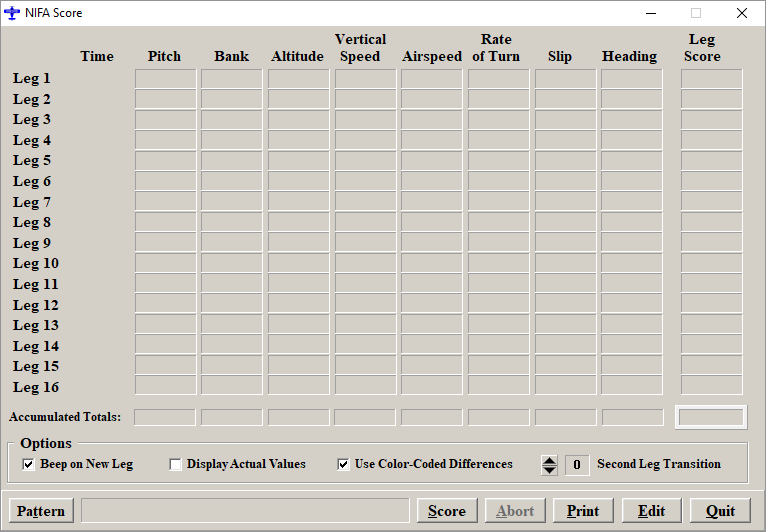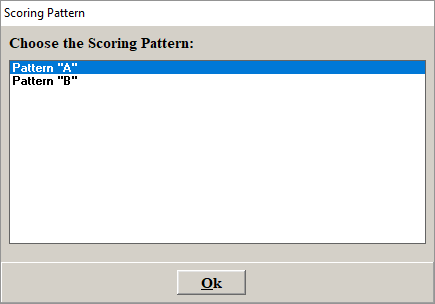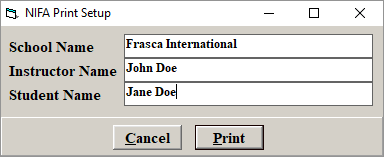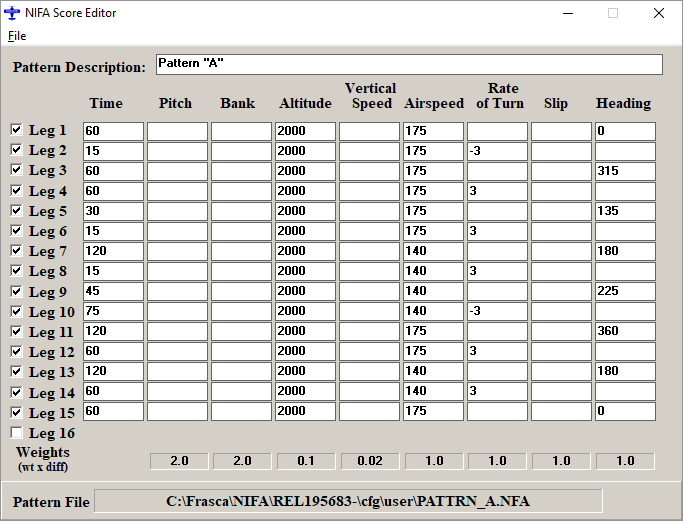The National Intercollegiate Flying Association (NIFA) Score Module provides an objective means of evaluating a pilots flying skill.
Table of Contents
Installing and Setting up NIFA Score Module on a Laptop
- Download the NIFA_Install.zip (under RTD downloads) file to the Windows laptop or tablet.
- Right-click on the NIFA_Install.zip file, select 7-zip, and then select Extract to “NIFA_Install”.
- Open the Install folder and right-click on the install.exe file, and select Run as administrator.
NOTE: If the installer is not Run as Administrator, it will not work properly.
- Follow the on screen instructions from the installer.
- Navigate to the C:\Frasca\NIFA\REL195683\utility directory.
- Right-click on the IosStarter shortcut (not on the IosStarter.exe), and select Send to, Desktop (create shortcut).
NOTE: Creating a shortcut to the IosStarter.exe will not allow NIFA to work properly, it must be a shortcut to the IosStarter shortcut.
- Navigate to the C:\Frasca\NIFA\REL195683\cfg\system directory.
- Edit the IOS.cfg file to match the following (see bold text), and then save the file.
; *************************************************************************
; ********************** HOST COMMUNICATIONS PORTALS **********************
; *************************************************************************[UDPRxPort1]
RemoteName=Host
RemoteIP=192.168.5.10
LocalIP=192.168.5.221
LocalPort=5001
RemotePort=4000
LAN=1[UDPTxPort1]
RemoteName=Host
RemoteIP=192.168.5.10
LocalIP=192.168.5.221
RemotePort=4501
LocalPort=5500
HeaderData=GISt
LAN=1
- Power up the RTD
- Connect the Laptop to the RTD Wi-Fi. The Wi-Fi name is the Serial Number (S/N) of the device as indicated on the lower right side of the instrument panel.
- Change the laptop’s wireless adapter IP Address to 192.168.5.221.
NOTE: If the Laptops wireless adapter that is used to connect to the RTD is not set to 192.168.5.221, it will not establish a connection to NIFA, and will not work properly.
- Press [Windows] key and search for and select Change Ethernet Settings.
- Select the Change adapter options link in the Related settings section.
- Right-click on the Wireless adapter, and select Properties.
- Select Internet Protocol Version 4 (TCP/IPv4), and then click the Properties button.
- Select Use the following IP address, and set the IP address to 192.168.5.221.
- Set the Subnet mask to the default 255.255.255.0.
- Click the Ok button.
- On the Desktop, right-click on the IosStarter shortcut, and select Run as Administrator.
NOTE: This step is only necessary on first time setup, after it has been run once as administrator, it can be run by double-clicking the desktop shortcut.
Setting up NIFA on the RTD
The following procedure is provided for manually setting up NIFA on the RTD to communicate with the NIFA Score software through the WiFi Router.
- Stop the current configuration, if it is running.
- Navigate to the C:\Frasca\Host\REL193380\ModelX\Common\IOS\NIFA directory on the RTD.
- Double-click the NIFA.cfg file to edit the contents.
- Edit the NIFA.cfg file to match the following (see bold text), and then save the file.
[TrainerID]
ID=99999001[IOSCommunicator]
NumUDPRxPorts=1
NumUDPTxPorts=1
EnablePacketRegulation = true[UDPRxPort1]
RemoteName=IOS
RemoteIP=WiFiTablet
LocalIP=WiFiHost
LocalPort=4501
RemotePort=5500
LAN=1[UDPTxPort1]
RemoteName=IOS
RemoteIP=WiFiTablet
LocalIP=WiFiHost
RemotePort=5001
LocalPort=4000
HeaderData=GISt
LAN=1[DataPackages]
NumDataPackages=1
DataPackage1=IOSNifaScoreDataPackage
- Shut Down the RTD.
- Power up the RTD.
Running a NIFA Score Pattern
To run a scoring pattern, an appropriate pattern must first be setup using the NIFA Score Editor.
- Power up the RTD.
- Connect the Laptop to the RTD Wi-Fi. The Wi-Fi name is the Serial Number (S/N) of the device as indicated on the lower right side of the instrument panel.
- Launch the NIFA Score Module by double-clicking the IosStarter desktop shortcut.

NIFA Score Module - Click the Pattern
- Select a pattern from the Scoring Pattern dialog box, and then click the Ok button.

NIFA Pattern Selection - Set Scoring Options: Certain scoring options can be set prior to a scoring session. Select each option near the bottom of the Module as needed.
- Beep on New Leg: The computer will generate a beep when one leg concludes and another begins.
- Display Actual Values: Actual flight parameter values appear in each cell of the current leg in place of penalty points.
- Use Color-Coded Differences: This color-codes unmet flight parameters. RED indicates actual performance is below the flight parameter, and GREEN indicates performance above the flight parameter. If the actual value matches the parameter, there are no background colors.
- Second Leg Transition: This represents the length of time after the beginning of a leg, penalty points do not accrue. This provides a grace period, to adjust the aircraft’s configuration to conform to the requirements of the new leg.
- Ensure that the pilot is ready to begin NIFA The pilot must fly the simulator as close as possible to the first leg values, in order that such dynamics as flight control trim and power are appropriate for the beginning of the pattern.
- When all is ready, click the Score button; Scoring begins immediately. The ideal flight parameters for the first leg are set automatically as the scoring begins to ensure a fair start.
As the flight progresses, the score pattern cells fill in with data. The current leg contains either the actual flight data or the accumulating penalty points, depending on the Display Actual Values option.
Completed legs contain the total penalty points for each parameter scored in that leg, as well as the total penalty points for the leg in the right column. The total score also updates as the flight progresses. When the entire pattern is complete, the total for each flight parameter scored appears at the bottom of its respective column, and the total for the entire pattern appears at the lower right. - Click the Abort button when scoring is complete.
Printing Score Results
- Click the Print button.

NIFA Score Print Options - Type the School Name, Instructor Name, and the Student Name.
- Click Print.
Creating a New NIFA Score Pattern
- Open the NIFA Score Module by double-clicking the IosStarter desktop shortcut.
- Click the Edit button.

NIFA Score Editor - On the NIFA Score Editor File menu, click New.
- Type a Pattern Description to identify or describe the pattern.
- Select the available Legs, by selecting the number of Leg check boxes needed for the pattern. The user may program as many as sixteen legs for each pattern.
- Type the score Weights along the bottom of the page. This assigns score weights to each scoreable flight parameter. The following table explains the meaning of these weights (X = value entered; recommended values are in parentheses).
Parameter Criteria for 1 penalty point Pitch, Bank X degrees deviation per second (2.0). Altitude X feet deviation per second (0.1). Vertical Speed X feet per minute deviation per second (0.02). Airspeed X knots deviation per second (1.0) Rate of Turn X degrees per second deviation per second (10.0). Slip X % ball scale, deflection deviation per second (1.0). Heading X degrees deviation per second (2.0). - Click each Weight box, enter the weight, and then click the Ok button.

NIFA Score Weight Dialog - Set the time duration (in seconds) for each leg in the Time Minimum value is “1,” maximum is 999 seconds.
If criteria are not used for any of the following items, leave the respective block empty, or delete the current value.
- Enter the Pitch, and Bank value(s) in degrees.
- Enter the Altitude value(s) in feet MSL.
- Enter the Vertical Speed value(s) in feet per minute.
- Enter the Airspeed value(s) in knots.
- Enter the Rate of Turn value(s) in degrees per second. The entry for a standard rate turn to the left would be –3; the entry for a half-standard rate to the right would be +1.5.
- Enter the Slip value(s) in percent of slip ball deflection. The entry for a centered slip ball would be “0.” The entry for 25% slip ball deflection to the left would be –25; the entry for 50% slip ball deflection to the right would be 50.
- Enter the Heading value(s) in degrees magnetic.
- On the File menu, click Save As to save a new score pattern, use Save to overwrite an existing pattern.
Printing a NIFA Score Editor Pattern
- Open the NIFA Pattern in the NIFA Score Editor.
- On the File menu, click Print.
- Type the School Name, and the Instructor Name.
- Click Print Grid to print in a grid as shown on the module, or click Print Test to print the test as instructions for the pilot.

NIFA Score Test Print Example
Editing an Existing NIFA Score Pattern
- On the File menu, click Open.
- Modify the score pattern as needed.
- On the File menu, click Save, to overwrite the existing pattern.
